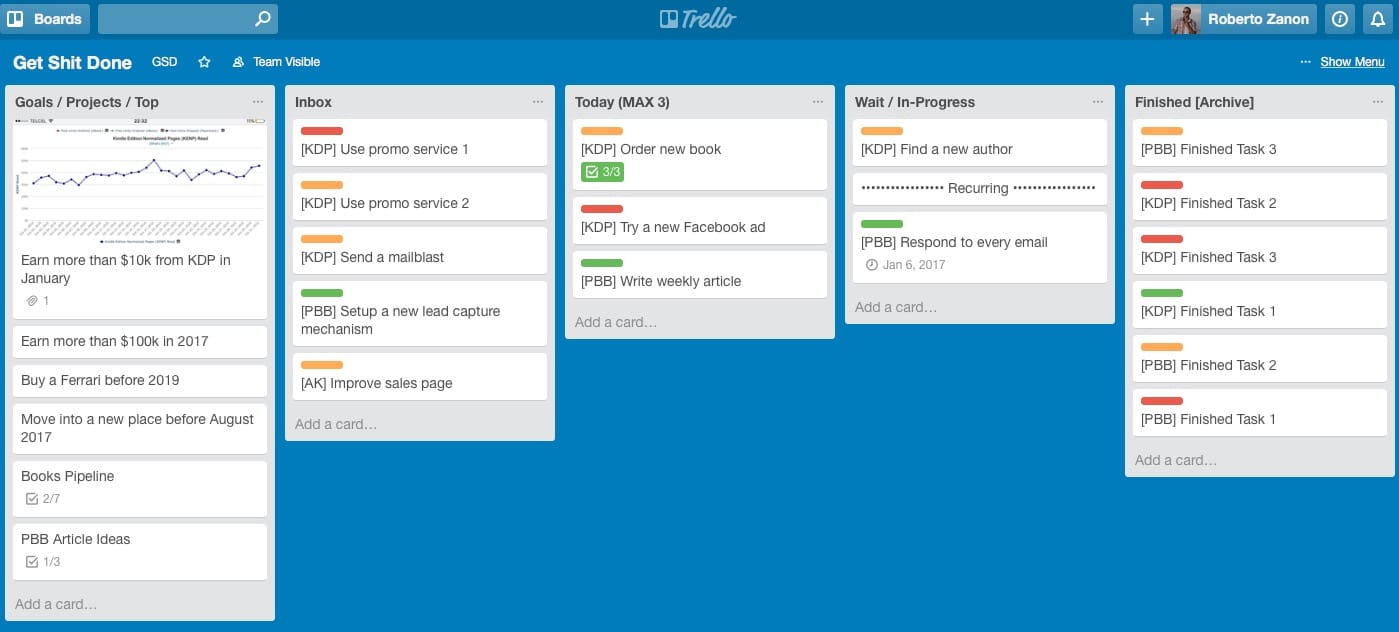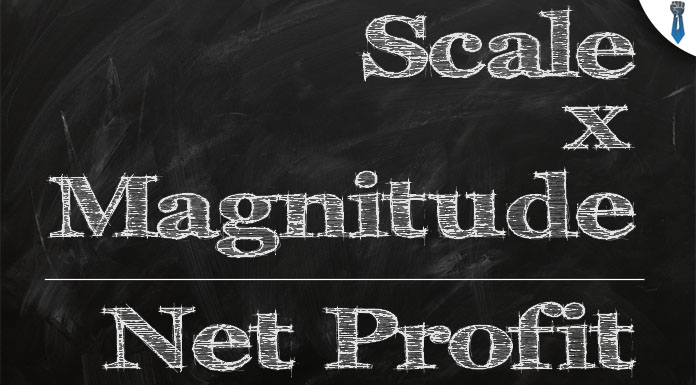You’ve seen me very often talk about excellence, greatness, financial freedom and all these kinds of ideas in this blog.
I can’t deny it, a solid mindset is always the starting point. Without it, all the technical knowledge in the world won’t be enough to make you a millionaire.
I’ve already said it times and again.
Correct Mindset + Technical Knowledge = Success
Today’s post is a bit technical though. I would like to share with you what I call the “Get Shit Done” board I use that helps me keep things organized and makes me a lot more productive.
Since I have incorporated into my productivity process, the results were fantastic. I wish I could say to you, my productivity went up by 58.64%, but that would be a lie.
What I can tell you for sure, is that, since I started using the GSD (Get Shit Done) system, I complete more tasks per day, my task manager (board actually) feels a lot more organized and my daily schedule seems a lot more “in place.”
Of course not even the best system in the world will make you work and be productive if the task(s) you have to do, don’t mean much to you. To have the discipline to stick to the plan, it will always need to be part of a bigger goal or purpose.
Why GSD system works
GSD system works because it’s based on a powerful psychological principle that all people are susceptible to. People by nature are creatures that want to undertake tasks and usually finish them.
As long as the job is as hard as it should be, the individual stays in flow, and he’s happy to do it. Mihaly Csikszentmihalyi (I copy > paste that) explains this exact principle in a lot of detail in his excellent book “Flow.”
But all task managers use well…tasks. What’s so special about GSD system?
Good question. Although all task managers include tasks (ya-ha), GSD system is designed in a way that still allows you to see the completed tasks every day without obstructing your working view.
Moreover, it’s based on the simple principle of prioritizing your tasks and letting you undertake only a max of three per day. That way you won’t be overwhelmed by the sheer number of open tasks in your inbox.
But enough with words. Let’s see how GSD system works in action.
How GSD system works
GSD system can be based on any software that allows you to use boards with cards. My personal preference is Trello, but there are more similar tools you can use out there, like the Asana, etc.
Here’s how the general overview looks like:

GSD system is based on five main columns. These are:
Column 1: Goals / Projects / Top
Column 2: Inbox
Column 3: Today (MAX 3)
Column 4: Wait / In-Progress
Column 5: Finished [Archive]
Let’s see these, one by one.
Column 1: Goals / Projects / Top
Here’s your first column. This is the inspirational, long-term, highest priority column.
This is where you will put all these ideas that are long-term or mid-term vision plans. As you can see in mine, I have included my top priority mid-term goals for 2016 and 2017. I even have included a longer term plan, which is to buy a Ferrari before 2019.
I use the top section of this column as my daily goal affirmations which I explain in detail in my wonder morning routine here.
Besides that, I also have some lists of the books I have in my pipeline and all the article ideas that come to mind for Project Be Best.
So instead of keeping different kinds of note papers for all these, I consolidated them to a single app – I hate app switching, I got to admit.
Column 2: Inbox
Column 2 is your inbox. Pretty obvious huh? This is where you’ll note EVERY single task or idea that comes to your mind. You don’t have to elaborate a lot. Only a short explanatory title will suffice.
The point here is to use this as your pool of ideas and tasks that you want to implement. If the task doesn’t seem relevant after a few days, you can always remove it.
But if I note down everything how am I going to prioritize things?
That’s why these apps are very handy. Do you see these colored labels in every task? Depending on the priority I give them a specific color code. Like for example:
- Red = Hot (urgent)
- Orange = Warm (can wait a bit)
- Green = Cool (will implement at some point)
Makes sense right?
If you’re anything like me, you’ll love to see your inbox getting shorter and shorter. This means that you’re in a position to accomplish goals at a faster pace. There’s something addictive about it.
Column 3: Today (MAX 3)
This is where it becomes interesting. Column 3 is your primary focus for the day. These are the only tasks you’ll undertake during the day. Nothing else. This is very crucial if you want to make this system work.
From time to time, you’ll be tempted to insert a new task in there. Don’t do it! If I say to ALWAYS have three task in here I say it for a reason.
We want to be as productive as possible. Not overwhelm ourselves. What I’d suggest you do is to fill this column with the three tasks from the day the night before. This way you’ll do ti while relaxed and with a clear mind.
If you do it before you start working, there’s a good chance your prioritization will be skewed and inefficient.
If you think you absolutely need to swap a task during the day because it suddenly became more urgent, feel free to do so. But based on my experience this will happen very rarely.
So, as soon as you complete one of the tasks in your “Today” column, you’ll be able to add a new one.
Column 4: Wait / In-Progress
Sometimes a few tasks will have to be paused due to factors not entirely up to you. That doesn’t mean you’ll stop everything you do because a particular task is in progress. That’s what this column is for.
Let’s say for example that you want to look for a new author to outsource your books. After the initial invitation for a job interview, there’s usually a downtime before you get your first answers back. This is when you’re “allowed” to move this task to the “Wait” column.
After you re-engage in this process, you can bring it back to the “Today” column or work with it to complete it.
You can also include here tasks that are recurring, like this weekly blog post, answering to your fans once or twice a week, etc.
You can also use the recurring feature upgrade of Trello to set these tasks up.
Column 5: Finished [Archive]
In the final column, we have the complete tasks we now have in our archive. Like I said before, GSD system uses this implementation to give you an extra motive to fill up this column.
In the same time, you’ll need to leave these tasks where they are (in column 5), and you won’t delete them. This is exactly because you want to see this column grow as fast and as big as possible.
After a couple of days, you’ll have completed various tasks, and you’ll feel this sense of accomplishment. The more tasks you complete, the more you’ll want to add.
It’s a circle of productivity that works!
In case you’re in look for a new task management method, or you’re simply an adventurous type who likes to try new things, give GSD system a try. I believe you’ll be pleasantly surprised on how much more productive you’ll become.
Also if you like the system, share this article so that more people can benefit by using it.


